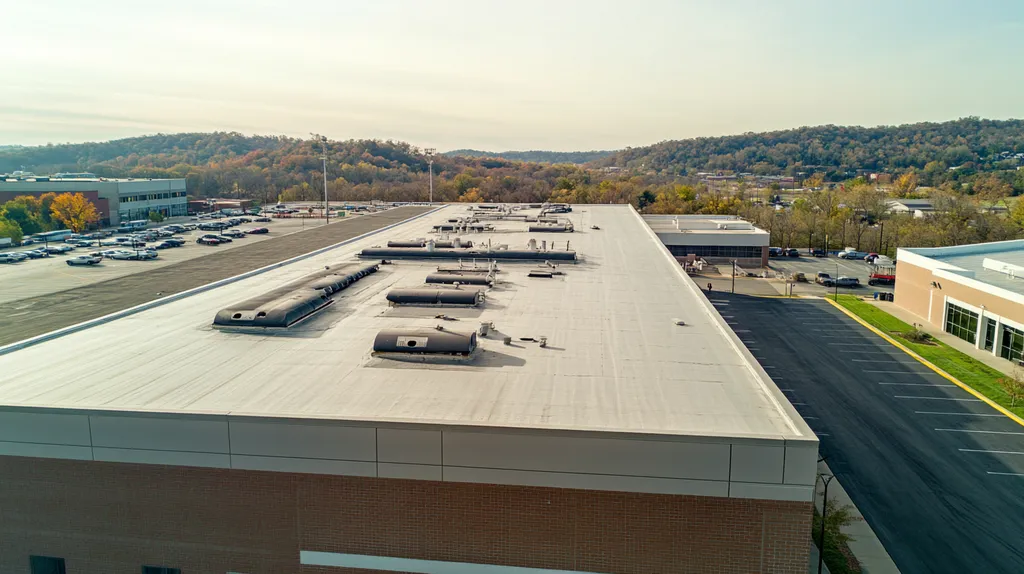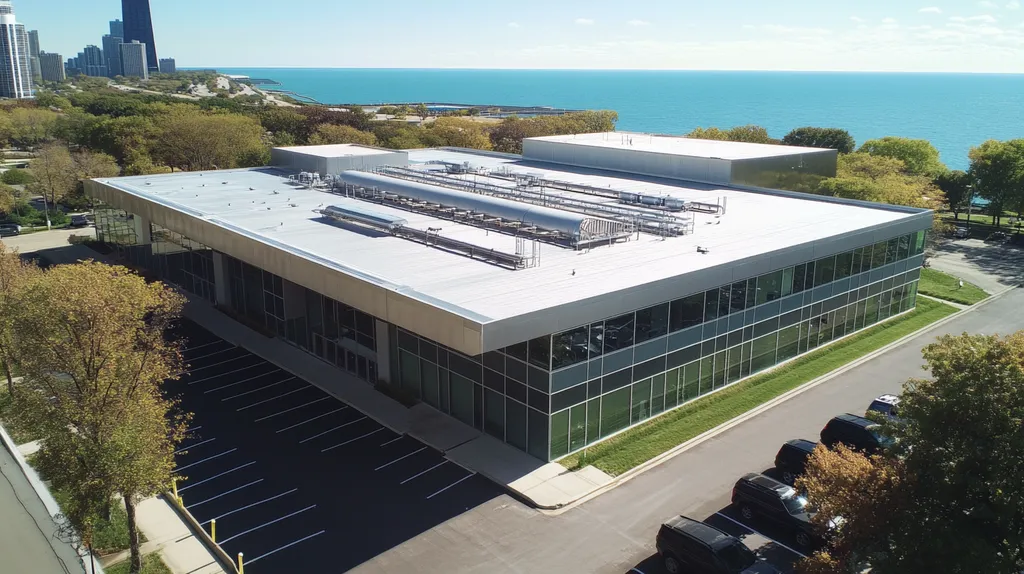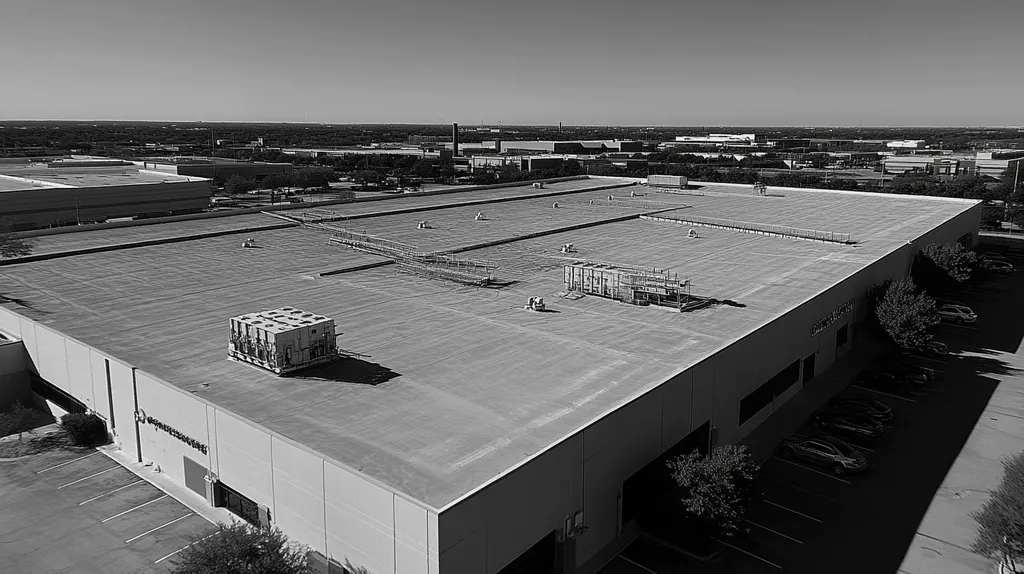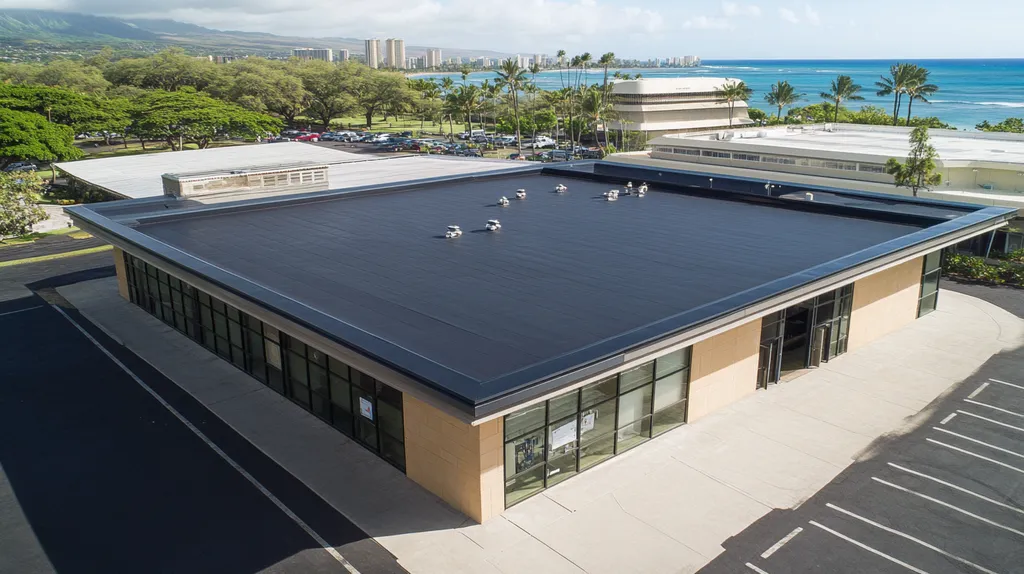Welcome to today’s Battle Royale featuring two roofing heavyweights: “Reflective Roof Coatings” in the east corner versus “Light-Colored Roofs” in the west!
Tonight’s showdown pits these contenders against each other across six punishing rounds designed to test every aspect of their performance for Commercial Roof Efficiency.
At stake? Millions in potential costs, decades of building protection, and the critical performance demands of modern commercial and industrial facilities.
Our professional judging panel will evaluate each round on technical merit, real-world performance, and value delivery. After all six rounds, we’ll declare our ultimate champion.
Ladies and gentlemen, facility managers and building owners… it’s time to rumble!
ROUND 1: INITIAL COSTS & INSTALLATION
When it comes to commercial roofing decisions, the stakes couldn’t be higher. Every square foot of roofing represents both an immediate cost and a long-term investment in building efficiency. The choice between reflective coatings and light-colored roofs can impact your bottom line for decades to come.
Coatings play a significant role in the energy performance of commercial buildings by improving the building envelope, which acts as a barrier between interior and exterior environments. Understanding the full cost implications of each option is crucial for making an informed decision. (source: Martin Specialty Coatings)
Material Expenses
Reflective roof coatings represent a specialized category of materials engineered specifically for maximum heat reflection. These advanced formulations typically command premium prices, with costs varying based on the specific coating type and coverage requirements.
The materials used in light-colored roofs, while still high-quality, generally align with standard roofing materials. This includes white or light-colored membranes, tiles, or metal panels that are produced at scale, resulting in more competitive pricing.
When comparing pure material costs, light-colored roofs maintain a clear cost advantage. Their established manufacturing processes and wider availability translate to lower material expenses, giving them the “ADVANTAGE” in this category.
Installation Complexity
Applying reflective coatings demands precise surface preparation and application techniques. The process includes thorough cleaning, repairs of existing surfaces, and careful monitoring of environmental conditions during application.
Light-colored roof installation follows conventional roofing methods that most commercial contractors regularly perform. This familiarity means fewer specialized tools and techniques are required, streamlining the installation process.
The straightforward nature of light-colored roof installation, combined with broader contractor availability, gives them a clear “ADVANTAGE” in terms of installation complexity.
Project Timeline
Reflective coating projects require multiple phases, including surface preparation, primer application, and final coating. Each phase needs specific curing times and optimal weather conditions, potentially extending the project duration.
Light-colored roof installations typically follow more predictable timelines. The familiar installation process allows for more accurate scheduling and fewer weather-dependent phases.
With fewer variables affecting the installation schedule, light-colored roofs earn the “ADVANTAGE” for project timeline considerations.
ROUND 1 WINNER: Light-Colored Roofs
ROUND 2: DURABILITY & LIFESPAN
Every day your commercial roof faces a barrage of challenges: scorching sun, pounding rain, extreme temperature swings, and physical stress. These environmental forces can reduce a roof’s lifespan by up to 50% if the wrong material choice is made. When considering durability, the stakes go far beyond simple maintenance – they directly impact your building’s protection and your operational budget.
Weather Resistance
Reflective roof coatings create a seamless, protective barrier that shields the underlying roof structure from UV radiation, moisture, and thermal stress. These specialized formulations include advanced polymers that maintain flexibility through extreme temperature cycles.
The coating’s reflective properties dramatically reduce heat absorption, lowering roof temperatures by up to 50°F and minimizing thermal expansion and contraction that can lead to cracks and failures. (source: Martin Specialty Coatings)
Light-colored roofs offer basic UV reflection but lack the advanced protective properties of specialized coatings. Their materials are more susceptible to degradation from temperature fluctuations and weathering.
The superior weather protection capabilities of reflective coatings give them the clear “ADVANTAGE” in this category.
Physical Durability
Reflective coatings form a tough, elastic membrane that can bridge minor cracks and adapt to substrate movement. This flexibility helps prevent damage from normal building settlement and thermal expansion.
These coatings also provide excellent resistance to impact damage from maintenance foot traffic and light debris. Their self-flashing properties help seal around penetrations and protect vulnerable areas.
Light-colored roofing materials rely solely on their inherent structural properties for durability. While many are reasonably tough, they can’t match the additional protective layer that coatings provide.
Reflective coatings earn the “ADVANTAGE” for superior physical durability and adaptive protection.
Maintenance Requirements
Reflective coatings typically require minimal maintenance beyond periodic cleaning and inspection. When repairs are needed, they can often be addressed with simple recoating of affected areas.
These coatings are also self-healing to a degree, able to reseal minor surface abrasions before they develop into serious problems. This characteristic reduces the frequency of repairs and extends service life.
Light-colored roofs need regular maintenance to prevent degradation and may require more frequent repairs as they age. Their repair processes are often more invasive and costly.
The lower maintenance burden of reflective coatings gives them the “ADVANTAGE” in this category.
ROUND 2 WINNER: Reflective Roof Coatings
ROUND 3: PERFORMANCE FACTORS
In today’s volatile energy market, the performance of commercial roofing systems can make or break a building’s operational budget. With utility costs reaching record highs, property owners face increasing pressure to maximize every square foot of their roofing investment. The right choice between reflective coatings and light-colored roofs can mean the difference between sustainable operations and escalating expenses.
Energy Efficiency
Reflective coatings represent the cutting edge of roofing technology, engineered specifically to maximize solar reflection and heat dissipation. These specialized formulations create a continuous barrier that dramatically reduces heat transfer into the building envelope.
Advanced coating systems can lower roof surface temperatures by up to 50°F compared to conventional roofing, significantly reducing the load on HVAC systems and extending equipment life. Coatings play a significant role in the energy performance of commercial buildings by improving the building envelope, which acts as a barrier between interior and exterior environments. (source: Martin Specialty Coatings)
Light-colored roofs offer basic reflective properties through their natural coloration but lack the enhanced performance characteristics of engineered coatings. While better than dark surfaces, they cannot match the thermal control of specialized reflective systems.
The superior energy management capabilities of reflective coatings earn them the clear “ADVANTAGE” in this category.
Temperature Control
Maintaining consistent roof temperatures is crucial for preventing thermal stress and protecting underlying structural components. Reflective coatings create a dynamic thermal barrier that actively manages heat flow throughout the day.
These advanced systems minimize temperature fluctuations between day and night cycles, reducing the expansion and contraction that can lead to premature aging and failure. Their specialized formulations maintain performance even under extreme temperature conditions.
Light-colored roofs provide passive temperature control through basic reflection but experience greater temperature swings. This variation can accelerate wear and potentially impact interior comfort levels.
The active thermal management properties of reflective coatings give them the “ADVANTAGE” for temperature control.
Surface Protection
The roof surface takes the brunt of environmental abuse, from UV radiation to chemical exposure. Reflective coatings form a renewable protective layer that shields the underlying roofing system from degradation.
This protective barrier can be refreshed or reapplied as needed, effectively resetting the clock on surface wear. The coating’s flexibility allows it to accommodate normal building movement while maintaining its protective properties.
Light-colored roofs rely solely on their base material properties for protection. Once this surface begins to degrade, the entire system becomes more vulnerable to damage and wear.
The superior protective qualities of reflective coatings earn them the “ADVANTAGE” in surface protection.
ROUND 3 WINNER: REFLECTIVE ROOF COATINGS
ROUND 4: MAINTENANCE REQUIREMENTS
Every year, commercial building owners spend millions on roof maintenance and repairs. Making the wrong choice between reflective coatings and light-colored roofs can multiply these costs exponentially. With maintenance representing up to 30% of total roof ownership costs over time, understanding the upkeep requirements of each option becomes crucial for protecting your investment.
Cleaning and Surface Care
Reflective coatings feature advanced self-cleaning properties that actively resist dirt accumulation and environmental contamination. These specialized surfaces maintain their reflective properties longer, requiring only basic cleaning 1-2 times per year.
When cleaning is needed, most reflective coatings respond well to gentle washing with standard commercial cleaners. Their seamless surface prevents debris from becoming deeply embedded, making maintenance procedures simpler and more effective.
Light-colored roofs tend to show dirt and staining more prominently, requiring more frequent cleaning to maintain their reflective properties. Their porous surfaces can trap contaminants, demanding more aggressive cleaning methods that may accelerate wear.
The reduced cleaning demands and superior self-maintaining properties give reflective coatings the clear “ADVANTAGE” in this category.
Repair Requirements
Reflective coatings act as a renewable protective layer that can be touched up or reapplied as needed. Small damages can often be addressed with simple spot repairs, preventing minor issues from escalating into major problems.
The flexible nature of these coatings allows them to bridge small cracks and adapt to normal building movement. This self-healing capability significantly reduces the frequency and complexity of repairs.
Light-colored roofs typically require more extensive repairs when damaged, often involving removal and replacement of affected sections. Their rigid structure means even minor damage can compromise larger areas, leading to more costly interventions.
The simplified repair process and adaptive properties give reflective coatings the “ADVANTAGE” for repair requirements.
Long-term Preservation
Reflective coatings maintain their protective properties through temperature extremes and environmental exposure. Their specialized formulations actively resist UV degradation and thermal stress, preserving the underlying roof structure.
These coatings contain materials that bounce sunlight and heat away, preventing the building from absorbing and retaining excess warmth, particularly during hot summer months. This protective barrier extends roof lifespan while reducing maintenance needs. (source: Martin Specialty Coatings)
Light-colored roofs gradually lose their reflective properties over time, requiring additional treatments or coatings to maintain performance. Their effectiveness diminishes more quickly in harsh environments, leading to increased maintenance frequency.
The superior preservation capabilities give reflective coatings the “ADVANTAGE” in long-term maintenance.
ROUND 4 WINNER: Reflective Roof Coatings
ROUND 5: SUSTAINABILITY CREDENTIALS
In today’s climate-conscious market, a commercial roof’s environmental impact carries more weight than ever before. With buildings accounting for nearly 40% of global energy consumption, choosing the right roofing solution has become a critical sustainability decision. The stakes are particularly high as regulatory requirements tighten and more companies commit to concrete environmental goals.
Life Cycle Impact
Reflective coatings provide exceptional environmental performance throughout their lifespan. These specialized formulations create a continuous protective barrier that actively reduces energy consumption and extends the life of existing roofing materials.
These coatings play a significant role in the energy performance of commercial buildings by improving the building envelope, which acts as a barrier between interior and exterior environments. Their application can lower roof temperatures by up to 50°F, significantly reducing cooling demands and associated carbon emissions. (source: Martin Specialty Coatings)
Light-colored roofs offer passive reflective benefits but lack the advanced thermal management properties of engineered coatings. Their performance typically degrades faster, requiring more frequent replacement and generating additional waste.
The superior life cycle performance of reflective coatings earns them the clear “ADVANTAGE” in this category.
Material Sustainability
Modern reflective coatings incorporate advanced eco-friendly formulations that minimize environmental impact. These materials often include recycled content and low-VOC compounds that reduce harmful emissions during application and throughout their service life.
The renewable nature of coating systems allows for multiple reapplications without removing existing layers. This approach significantly reduces landfill waste and preserves embodied energy in the existing roof structure.
Light-colored roofing materials typically rely on traditional manufacturing processes with higher environmental impacts. Their production often requires more raw materials and energy, resulting in a larger carbon footprint.
The environmentally conscious formulation of reflective coatings gives them the “ADVANTAGE” in material sustainability.
Green Building Certification
Reflective coatings contribute significantly to green building certifications like LEED and Energy Star. Their proven energy reduction capabilities and documented environmental benefits align perfectly with current sustainability frameworks.
These systems often earn additional certification points through their heat island reduction properties and ongoing performance monitoring capabilities. Their flexibility in application methods also supports adaptive reuse and renovation projects.
Light-colored roofs meet basic certification requirements but may struggle to achieve higher-tier ratings. Their limited performance data and less sophisticated monitoring options can restrict certification potential.
The superior certification potential of reflective coatings earns them the “ADVANTAGE” in this category.
ROUND 5 WINNER: REFLECTIVE ROOF COATINGS
ROUND 6: SPECIALIZED APPLICATIONS
Commercial roofing decisions have never been more critical, with energy costs soaring and climate challenges intensifying. Modern buildings face unprecedented demands, from extreme weather events to strict energy regulations. The right specialized application can reduce cooling costs by up to 40% and extend roof life by decades, while the wrong choice can lead to premature failure and skyrocketing utility bills.
Climate Adaptability
Reflective coatings demonstrate remarkable versatility across diverse climate zones. Their advanced formulations maintain performance through extreme temperature swings, heavy precipitation, and intense UV exposure.
These coatings excel particularly in hot climates, where their thermal management properties can reduce roof surface temperatures by up to 80°F. Their moisture-resistant properties also provide superior protection in regions with high rainfall or humidity.
Light-colored roofs offer basic heat reflection but struggle to maintain performance in extreme conditions. Their effectiveness diminishes significantly in areas with high UV exposure or frequent precipitation.
The superior environmental adaptability of reflective coatings earns them the clear “ADVANTAGE” in this category.
Building Type Compatibility
Reflective coatings prove exceptionally versatile across different building types and roof configurations. They conform seamlessly to complex geometries, effectively protecting difficult details like penetrations, flashings, and mechanical equipment mounting points.
These systems excel on large commercial facilities where their continuous membrane eliminates vulnerable seams and transitions. Their lightweight nature makes them ideal for structures with load restrictions.
Light-colored roofs face limitations with certain building designs and often struggle with complex roof geometries. Their rigid nature can create challenges around equipment and penetrations.
The superior adaptability to various building types gives reflective coatings the “ADVANTAGE” in this category.
Performance Optimization
Reflective coatings can be customized to meet specific performance requirements. Their formulations can be adjusted to emphasize particular properties like chemical resistance, impact resistance, or enhanced UV protection.
These systems allow for targeted reinforcement of high-stress areas and can be recoated to restore performance without removal. Their renewable nature supports long-term optimization strategies.
Light-colored roofs offer limited optimization options once installed. Their performance characteristics remain largely fixed, requiring full replacement to address changing requirements.
The superior flexibility in performance optimization gives reflective coatings the “ADVANTAGE” in this category.
ROUND 6 WINNER: Reflective Roof Coatings
AND THE WINNER IS…
After six grueling rounds of technical analysis, we have our undisputed champion! With a dominant 5-1 victory, REFLECTIVE ROOF COATINGS has claimed the Commercial Roof Efficiency title!
This powerhouse contender dominated the competition through superior performance in durability, energy efficiency, maintenance requirements, sustainability, and specialized applications. Its advanced formulations and adaptive capabilities proved unstoppable in the ring.
Light-Colored Roofs showed impressive strength in Round 1, winning on initial costs and installation simplicity. For projects where budget constraints are the primary concern, this contender remains a viable challenger.
However, we must acknowledge that every building represents its own unique battleground. Local climate conditions, structural requirements, and specific property characteristics can shift the competitive advantage. While today’s match provides valuable insights, building owners and facility managers should always consult with qualified roofing professionals who can evaluate their specific situation.
Ladies and gentlemen, in the high-stakes arena of commercial roofing, success depends on matching your building’s unique requirements with the right contender’s strengths. Choose wisely – because in this game, there are no rematch guarantees!
FREQUENTLY ASKED QUESTIONS
Q. What are the initial costs for a commercial roof with coatings?
A. The initial costs for reflective coatings tend to be higher due to specialized materials. Light-colored roofs usually have lower material expenses, making them a more affordable option initially. However, consider long-term energy savings and durability when weighing costs.
Q. How does the durability of an industrial roof compare between coatings and light-colored roofs?
A. Reflective coatings provide a more durable solution, as they can adapt to physical movements and prevent environmental damage. On the other hand, light-colored roofs may not withstand extreme conditions as well, limiting their longevity and performance.
Q. What energy efficiency benefits do reflective coatings provide for commercial roofs?
A. Reflective coatings significantly enhance energy efficiency by reducing heat transfer into the building. This not only lowers roof surface temperatures but also eases the workload on HVAC systems, which can result in substantial energy savings over time.
Q. What are the maintenance requirements for a commercial roof with coatings?
A. Commercial roofs with reflective coatings require minimal maintenance, mainly periodic cleaning and inspections. Unlike light-colored roofs, which may need more frequent and invasive maintenance, coatings can often be repaired with simple spot treatments.
Q. How do reflective coatings impact the sustainability credentials of a commercial roof?
A. Reflective coatings greatly enhance sustainability by improving energy efficiency and reducing the carbon footprint over their lifespan. They also support compliance with green building certifications, making them a smart choice for environmentally conscious property owners.
Q. Are reflective coatings suitable for all climates on commercial roofs?
A. Yes, reflective coatings are designed to perform well across various climate zones. They excel in extreme temperatures and heavy precipitation, making them adaptable for most commercial roofs, unlike light-colored roofs that may not perform as effectively in harsh conditions.
Q. How can I ensure the best performance from my commercial roof?
A. To maximize your roof’s performance, consider the specific needs of your building and local climate. Regular maintenance, proper installation, and choosing the right reflective coating or material will help sustain its efficiency and longevity.











